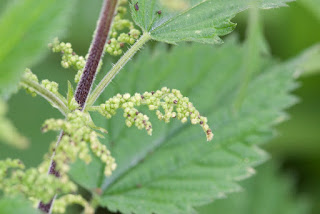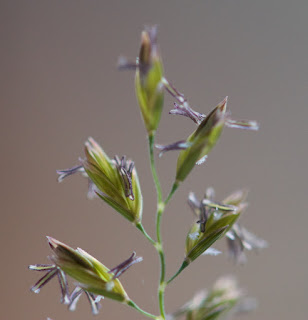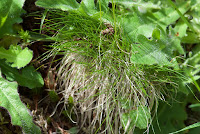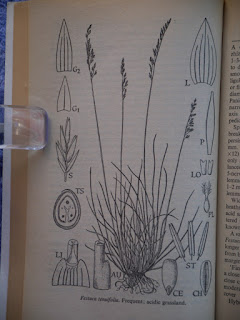I spotted a white foxglove so donned my midge jacket and went for a closer look. Then I did a Boggy Brae wander in search of whatever might have turned up since my last look. My searches are not aimless. I remember where things have turned up before and keep checking to see if they reappear. Sometimes something new turns up.
First I looked round the base of a wild cherry tree to check the progress of the Lesser Stitchwort that lives there. Sitting on an old, punctured Thermarest mattress that last summer my grandsons used as a summer sledge down the Boggy Brae banks, and peering through the midge netting covering my face, I took some hazy photos of it.
 |
| Lesser Stitchwort (Stellaria graminea) |
In my quest to remember botanical names I shall think of this as the star flower in the grass. the Latin name actually describes it perfectly. Was stitchwort a cure for stitches or does the English name mean something else?
I enjoyed the haziness of the photos when I looked at them on the Mac.
Then I spotted something reddish purple where red clover does not gow but where a Northern Marsh Orchid has been known to pop up. Sure enough, that's what it was. I left its protecting Cat's-ear in situ and marked the spot for mowers to avoid.
Checking other known orchid spots, I found another Northern Marsh Orchid among the tall fescue grass on the south-east bank and the leaves and early spike of a Southern Marsh Orchid on the north-east bank where it has flowered for several years.
 |
| Northern Marsh Orchid (Dactylorhiza purpurella) |
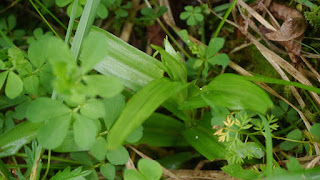 |
Southern Marsh Orchid (Dactylorhiza praetermissa)
at summer solstice this year |
 |
Southern Marsh Orchid,
in the same spot as above,
at summer solstice last year |
In the boggy lawn below the north-east bank clumps of Star Sedge are making a pale yellowish haze.
 |
| Star Sedge (Carex echinata) |
The Yellow Flags have finally got going and the flag patch looks good with the Meadow Buttercups around it.
Toad has finally got rid of his Wayfarer dinghy that hasn't been on the water for a decade. The Vice-Commodore of a local sailing club has taken it away to make it seaworthy again so it can be used as a training boat. We're pleased about that. I had mentioned that I needed to have it moved so that I could burn the pampas grass. Once every few years the clump needs to be set alight in dry weather to keep it under control. The little Topaz dinghy has been dragged up the hill a bit to be out of the way too. There's a big muddy patch where they have been and I discovered a new plant, which almost but not quite got crushed in the boat moving operations – boat moving operations that required a tow rope and the Rattletrap in haul away mode because the boat trolley wheels had sunk so far into the mud that they were unbudgeable without a fair tonnage of pulling power. Bog power!
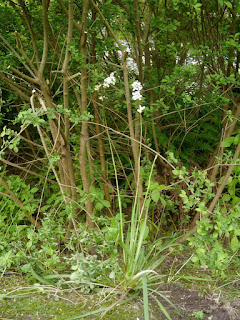
 |
|
This is the new plant. It's nearly a metre tall. The leaves are mostly basal and are flat and ridged with slightly ripply edges. If anyone recognises it, please do let me know. There are mosses and liverworts in the Boat Bog area too. More on them anon.

















